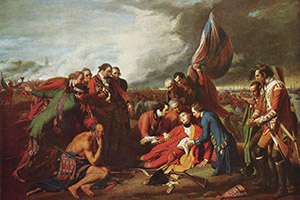
History-Periods
Past eras

From pre-history to today
Choose your period

Periods of History
explore the different eras

The Seven Years' War, also known as the French and Indian War, was a global conflict that lasted from 1756 to 1763. It involved most of the major European powers, with Britain and Prussia fighting against France, Austria, and Russia.
In North America, the war was fought between Britain and France for control of the continent. The strategic situation at the beginning of the war favored the French, who had a well-established network of forts and trading posts in the Ohio River Valley and along the Mississippi River. The British, on the other hand, were largely confined to the eastern seaboard.
To counter the French presence in North America, the British decided to launch a series of campaigns to capture French forts and trading posts. The first target was Louisbourg, a heavily fortified port on the east coast of Canada that served as a base for French naval operations in the region.
The capture of Louisbourg was a critical victory for the British, as it denied the French a key strategic base and allowed the British to control the entrance to the St. Lawrence River, a vital artery for French supply lines. The campaign was led by General Jeffery Amherst, who arrived in June 1758 with a force of over 14,000 troops.
The British forces besieged Louisbourg for seven weeks, bombarding the fort with artillery and cutting off the French supply lines. The French eventually surrendered on July 26, 1758, and the British took control of the fort and its garrison.
Following the capture of Louisbourg, the British turned their attention to Quebec, the capital of New France. The Quebec campaign was led by General James Wolfe, who arrived in Canada with a force of around 8,000 troops in June 1759.
The strategic situation in Quebec was favorable to the French, as the city was protected by steep cliffs and strong fortifications. However, Wolfe devised a daring plan to attack the city by scaling the cliffs at night and surprising the French defenders.
The plan was successful, and the British were able to capture Quebec on September 13, 1759, in a decisive victory that effectively ended French resistance in Canada. The French would surrender the rest of their North American possessions to the British in the Treaty of Paris in 1763, marking the end of the Seven Years' War.
The expedition led by General James Wolfe and supported by Admiral Charles Saunders was a critical campaign in the Seven Years' War, as it aimed to capture the French city of Quebec and deal a decisive blow to French forces in North America.
The expedition set sail from Louisbourg in June 1759 and made its way up the St. Lawrence River towards Quebec. The journey was challenging, as the river was heavily defended by the French, who had established a network of forts and gun batteries along its banks.
Wolfe and Saunders navigated the river carefully, using their superior naval firepower to suppress French defenses and clear the way for their troops to land. They also sent a detachment of troops under the command of Colonel Robert Monckton to capture the city of Fort Beausejour, which guarded the mouth of the St. Lawrence.
By August, the British had reached Quebec and began to prepare for a siege. The city was heavily fortified, with steep cliffs and strong walls protecting it from attack. The French forces, led by the Marquis de Montcalm, outnumbered the British and were well supplied, making the task of capturing the city all the more difficult.
Wolfe's initial strategy was to attack the city head-on, but this proved unsuccessful. The French defenses were too strong, and the British suffered heavy losses in a series of failed assaults. Wolfe then decided to change tactics, and he devised a daring plan to scale the cliffs that protected the city.
On the night of September 12, 1759, Wolfe led a small force of troops up a narrow path to the top of the cliffs. The climb was treacherous, and several men fell to their deaths in the attempt. However, Wolfe and his men made it to the top undetected and quickly established a foothold on the Plains of Abraham, a plateau overlooking the city.
Montcalm, taken by surprise, quickly gathered his troops and marched out to meet the British on the plains. The ensuing battle was fierce, but the British were able to hold their ground and inflict heavy casualties on the French. Both Wolfe and Montcalm were mortally wounded in the battle, but the British emerged victorious.
The capture of Quebec was a critical victory for the British, as it effectively ended French resistance in Canada and paved the way for the eventual British victory in the Seven Years' War. Wolfe's daring plan to scale the cliffs and his willingness to adapt his strategy in the face of adversity were key factors in the British victory.
James Wolfe was born on January 2, 1727, in Westerham, Kent, England. He was the eldest son of Lieutenant General Edward Wolfe, a veteran of the War of the Spanish Succession. Wolfe was educated at the Greenwich Hospital School and later attended the University of Oxford.
In 1740, at the age of 13, Wolfe enlisted in the British Army as a second lieutenant in his father's regiment. He quickly rose through the ranks, and by the age of 22, he had been promoted to the rank of captain.
Wolfe saw action in the War of the Austrian Succession and the Jacobite Rising of 1745. He also served in Scotland, where he was noted for his bravery and tactical skill.
In 1757, Wolfe was appointed to lead an expedition to capture the French fortress of Louisbourg in Nova Scotia. The campaign was successful, and Wolfe was hailed as a hero for his role in the victory.
Two years later, Wolfe was chosen to lead the expedition to capture Quebec, a critical French stronghold in North America. The campaign was challenging, but Wolfe's daring plan to scale the cliffs and surprise the French defenders proved to be a turning point in the war.
Wolfe's victory at Quebec and his subsequent death in the battle made him a national hero in Britain. His name became synonymous with courage, determination, and military skill, and he was immortalized in art, literature, and song.
One of the most famous legends associated with Wolfe is the story of his final moments on the battlefield. According to the legend, as Wolfe lay dying from his wounds, he overheard a soldier nearby saying, "They run! See how they run!" Wolfe, who had been informed that the French were retreating, reportedly whispered, "Who runs?" When told it was the enemy, he replied, "Then God be praised, I die in peace." While the story is likely apocryphal, it has become a key part of Wolfe's legend and is often cited as an example of his courage and dedication to duty.
Overall, James Wolfe was a military leader who achieved legendary status for his victories in the Seven Years' War and his contribution to British colonial expansion. His tactical skill, courage, and determination on the battlefield have made him a celebrated figure in British history.
If you have a suggestion regarding additional topics you would like to see included - please let us know
Reference: Article by Greg Scott (Staff Historian), 2023
Tour Reviews
History Attractions
Submit Tour Suggestions
2024 Departures
Spotlight Tours
Events and anniversaries

All content and images are protected by copyright to Access History